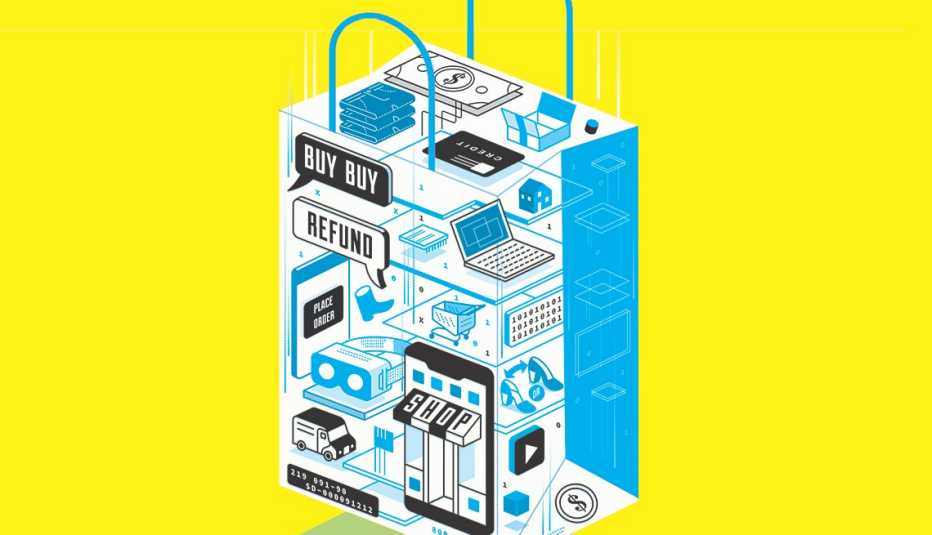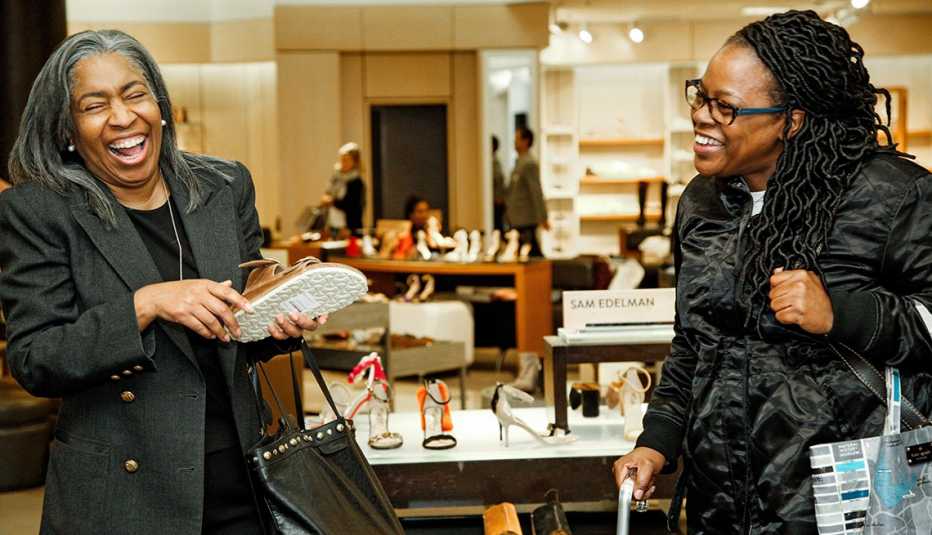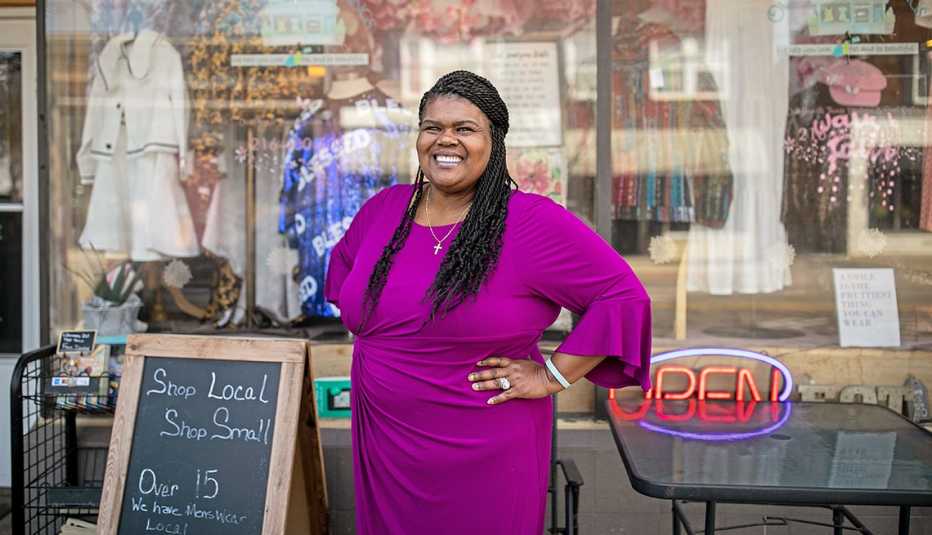AARP Hearing Center


Shopping never really changes: You browse, you select, you pay. And occasionally, if it doesn’t work out, you return. But dig into the details of how you do any of those tasks today, and everything about shopping is changing. Technology and shifts in consumer expectations accelerated by the pandemic are transforming the online and in-store experience from start to finish.
Whether you frequent dollar stores or upscale retailers, shopping is getting easier and more fun with faster delivery options; quick, cashless checkouts; virtual try-ons; and instant customer service. Other trends, like cash-back apps and the move by major retailers to sell secondhand goods, make it easier to save.
Here’s a breakdown of top trends shaping how we shop — and how you can take advantage of them. To come up with this list, I prowled the annual convention of the National Retail Federation (NRF) in New York City, interviewed industry professionals, combed through surveys and research reports and did lots of shopping online, on my phone, on main streets, in malls, and at big box stores and outlets. Although many developments in retail are aimed at younger generations, they affect us all. The pros are more personalization and convenience; the big con (pun intended!) is our loss of privacy from data collection that drives many of these innovations.
1. Your phone is now a favorite store
No other change has altered the American retail world in the past decade as much online shopping. The COVID-19 pandemic took the shift to even greater levels. In 2022, digital retail spending grew 11 percent — faster than traditional retail growth — leading to the first-ever year of $1 trillion in U.S. online sales, reports the research firm Comscore.
As sales have surged, so has convenience. You can buy anything from anywhere, even life’s biggest purchases, such as cars and furniture. Amazon offers delivery in some cases within an hour or two, or even sooner, for many items. Or you can opt for delivery services such as DoorDash, Instacart, Shipt and Uber Connect.
Another delivery option that exploded during the pandemic is BOPIS (“Buy Online, Pick Up In Store”), which combines the convenience of online shopping with the instant gratification of in-store purchases. Other benefits include instant returns and not having to worry about porch pirates. According to the International Council of Shopping Centers, more than half of U.S. shoppers use BOPIS.
Voice ordering (via Amazon Alexa and Google Assistant) and text-to-shop programs make shopping quick and stress-free. In the mood for something sweet from your grocer? You could text “vanilla ice cream” to Walmart’s app, for example, or say, “Hey Google, ask Kroger to add vanilla ice cream to my cart.”
My tips
Convenience often comes at a price. Delivery costs can add up fast, especially when ordering groceries. Also, it can encourage impulsive purchases. Even if you spend within your means, time-savers and shortcuts such as voice ordering can make you a lazy shopper and discourage deal hunting.
When shopping online, always compare prices. Tools that can help you include Google Shopping, retailers’ sites and apps (like the ones from Amazon, Walmart and eBay) and the CNET Shopping downloadable browser extension. Browser add-ons from sites including RetailMeNot, PayPal Honey and Rakuten can automate your savings; when you’re on the checkout screen of a retailer’s site, discount coupon codes will pop up. You can add them to your order with a click.
2. Ads are now super personal
Artificial intelligence and other advancing technologies enable increasingly personalized advertisements, product recommendations, search results, chatbot chats and special offers that have your name on them — figuratively and literally. Not only that, ads can target you everywhere you go: on websites, social media feeds, in email inboxes, on store receipts, on your phone while you’re out shopping or even on a fitting room mirror (more on that later).
NRF exhibitor Eli Finkelshteyn, CEO of the e-commerce software company Constructor, showed me how personalization works using a grocery store website. In a very basic example, after he added “organic milk” to his online cart, the search results for other items he typed in favored organic products. Each search term further customizes results as it gathers data, personalizing not just search results but also ads, product recommendations and more.
Data collection doesn’t stop there. We invite marketers a little deeper into our lives every time we join a loyalty program, download an app or walk into a store. (One NRF exhibitor who sells camera systems that track shoppers said, “If you start looking for them, they’re all over the place!”) Just using a retailer’s Wi-Fi can mean you’re agreeing the store can collect data from you, says Deborah Weinswig, CEO of Coresight Research.
Although recent laws such as the California Consumer Privacy Act and other changes are reining in sneaky tracking activity, there are plenty of ways to get us to give up our privacy. Vendors at the NRF convention showcased data-collection products they promised were compliant with new privacy laws, including a camera system that captures your age and gender, and a sensor that can detect your mood.
My tips
Don’t give away your data unless you get something you consider valuable in return. If you regularly shop at Kohl’s, for example, you would want to weigh the value of Kohl’s Rewards; perks include a 15-percent-off coupon when you join, 5 percent rewards and Kohl’s Cash on every purchase, and a birthday gift. Another reason to be selective about sharing personal information: Many retailers have experienced data breaches. Use a different password for each site, and provide the least amount of information necessary to get discounts and other rewards.


3. Machines are replacing people
Anyone who’s been at a store lately can see that self-checkout kiosks are spreading. A study by Zebra Technologies shows that more than half of shoppers actually prefer them to human cashiers. Some speedy systems add up your cart without barcode scanners. Many let you pay without cash or a credit card; simply use a payment app or a buy-now-pay-later option on your phone. Amazon’s Just Walk Out technology eliminates checkout entirely — scan your palm or dip a credit card at the entrance and just leave with your purchases.
Soon, customer service will be fully automated. Many websites have chatbots instead of humans to answer questions. In stores, your phone can stand in for clerks to help you find what you’re looking for. NRF exhibitor Pointr showed me how its technology brings directions in the style of digital road maps to the inside of stores and malls.
My tips
The next time you’re frustrated because you can’t find a salesperson at a store, try picking up your smartphone and checking the retailer’s app. Some have maps that can give you turn-by-turn directions to an item. An app might tell you if that item is in stock and give you product details and user reviews. In addition, many retailer apps can alert you to sales and special offers.






































































More From AARP
Best Bargains at Warehouse Clubs
Save on prescription drugs, hearing aids, eyeglasses
7 Easy Ways to Stop Money Leaks
Household expenses you don't need